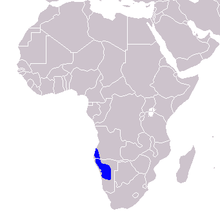Monteiro's hornbill
| Monteiro's hornbill | |
|---|---|
%2C_crop.jpg) | |
| Adult male at Spitzkoppe, Namibia | |
| Scientific classification | |
| Kingdom: | Animalia |
| Phylum: | Chordata |
| Class: | Aves |
| Order: | Bucerotiformes |
| Family: | Bucerotidae |
| Subfamily: | Bucerotinae |
| Genus: | Tockus |
| Species: | T. monteiri |
| Binomial name | |
| Tockus monteiri Hartlaub, 1865 | |
 | |
| resident range | |
The Monteiro's hornbill (Tockus monteiri) is a species of hornbill that is native to the dry woodlands of southwestern Africa. It is a common, near-endemic species in Namibia, with a total population estimated at 340,000 individuals.
Description
It is a medium-sized bird, 54–58 cm (21–23 in) in length, characterized by a white belly, black back, with white spots on the wings and white secondary flight feathers. The outer feathers of the long tail are also white. Females are smaller than males and can be recognized by turquoise facial skin. The eyes are black and the beak is red.
Range and habitat
Its habitat is the savannah and dry thornveldt of northwestern Namibia and southwestern Angola.
Habits
Unlike other hornbills, which are omnivorous, the Monteiro's hornbill feeds exclusively on insects and other small arthropods. In springtime, Monteiro's hornbills migrate to the southern Windhoek region to nest. They are adapted to the arid environment, and drinking is not a vital necessity for them. They breed at the end of a good rainy season, laying 3 to 5 greyish-white eggs, which hatch after about 45 days. The nest is built on rock faces or in trees.
Gallery
.jpg) Immature bird in Namibia
Immature bird in Namibia.jpg) Adult male at Spitzkoppe, Namibia
Adult male at Spitzkoppe, Namibia Illustration by Finch-Davies
Illustration by Finch-Davies_BHL38534729.jpg) Illustration by Keulemans
Illustration by Keulemans
References
- ↑ BirdLife International (2012). "Tockus monteiri". IUCN Red List of Threatened Species. Version 2013.2. International Union for Conservation of Nature. Retrieved 26 November 2013.
External links
- Monteiro's hornbill - Species text in The Atlas of Southern African Birds.
| Wikimedia Commons has media related to Tockus monteiri. |
